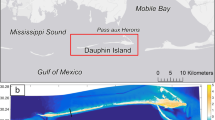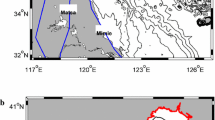Abstract
Hurricanes with high winds can generate strong ocean circulation, storm surges, and large surface waves that impact coastal regions. In 2018, Hurricane Florence crossed the narrow continental shelf and made landfall in Onslow Bay, North Carolina, USA, a 160 km curved embayment rimmed by a chain of barrier islands with inlets and narrow back-barrier lagoons. This storm had significant impacts to Bear Island, an undeveloped barrier island, including overwash and shoreline recession of the beach/dune system of up to 40 m. The objective of this study is to apply a flexible mesh numerical model to investigate wave generation by wind over the ocean, and the fine-scale response of flow and storm surge in shallow nearshore areas including inlets and back-barrier estuaries. The hydrodynamic conditions surrounding four different barrier island systems that received different hurricane wind and wave forcing relative to the cyclone eye are investigated. The highest total water levels around the barrier islands are driven by the combined tide, storm surge and waves, resulting in complex circulation patterns related to the network of shallow channels in the back-barrier environment.













Similar content being viewed by others
Data Availability
The data is available upon request. Please contact the corresponding author.
References
Almasy, S., & D. Andone. 2021. Why Ida’s storm surge potential should worry coastal communities. CNN.
Amante, C., & B.W. Eakins. 2009. ETOPO1 arc-minute global relief model: Procedures, data sources and analysis.
Antolínez, J.A.A., F.J. Méndez, D. Anderson, P. Ruggiero, and G.M. Kaminsky. 2019. Predicting climate-driven coastlines with a simple and efficient multiscale model. Journal of Geophysical Research Earth Surface 124: 1596–1624.
Ashall, L.M., R.P. Mulligan, D. van Proosdij, and E. Poirier. 2016. Application and validation of a three-dimensional hydrodynamic model of a macrotidal salt marsh. Coastal Engineering 114: 35–46.
Bao, D., Z.G. Xue, J.C. Warner, M. Moulton, D. Yin, C.A. Hegermiller, J.B. Zambon, and R. He. 2022. A numerical investigation of Hurricane Florence‐induced compound flooding in the Cape Fear Estuary using a dynamically coupled hydrological‐ocean model. Journal of Advances in Modeling Earth Systems 14 (11): p.e2022MS003131.
Battjes, J.A., & Janssen. J. 1978. Energy loss and set-up due to breaking of random waves. In Coastal Engineering 1978 (pp. 569–587).
Bennett, V.C., and R.P. Mulligan. 2017. Evaluation of surface wind fields for prediction of directional ocean wave spectra during Hurricane Sandy. Coastal Engineering 125: 1–15.
Bennett, V.C., R.P. Mulligan, and C.J. Hapke. 2018. A numerical model investigation of the impacts of Hurricane Sandy on water level variability in Great South Bay, New York. Continental Shelf Research 161: 1–11.
Benjamin, S.G., S.S. Weygandt, J.M. Brown, M. Hu, C.R. Alexander, T.G. Smirnova, J.B. Olson, E.P. James, D.C. Dowell, and G.A. Grell. 2016. A North American hourly assimilation and model forecast cycle: The Rapid Refresh. Monthly Weather Review 144 (4): 1669–1694.
Booij, N., R.C. Ris, and L.H. Holthuijsen. 1999. A third‐generation wave model for coastal regions: 1. Model description and validation. Journal of Geophysical Research: Oceans 104 (C4): 7649–7666.
Brown, M.M., R.P. Mulligan, and R.L. Miller. 2014. Modeling the transport of freshwater and dissolved organic carbon in the Neuse River Estuary, NC, USA following Hurricane Irene (2011). Estuarine, Coastal and Shelf Science 139: 148–158.
Cyriac, R., J.C. Dietrich, J.G. Fleming, B.O. Blanton, C. Kaiser, C.N. Dawson, and R.A. Luettich. 2018. Variability in Coastal Flooding predictions due to forecast errors during Hurricane Arthur. Coastal Engineering 137: 59–78.
Dally, W.R., and D.A. Osiecki. 2005. Nearshore wave and current measurements during Hurricane Jeanne. Shore and Beach 73 (2/3): 29.
Deltares. 2022. D-Flow FM Technical reference manual. The Netherlands.
Dietrich, J.C., M. Zijlema, J.J. Westerink, L.H. Holthuijsen, C. Dawson, R.A. Luettich Jr., R.E. Jensen, J.M. Smith, G.S. Stelling, and G.W. Stone. 2011. Modeling hurricane waves and storm surge using integrally-coupled, scalable computations. Coastal Engineering 58 (1): 45–65.
Elko, N., F. Feddersen, D. Foster, C. Hapke, J. McNinch, R. Mulligan, H.T. Özkan-Haller, N. Plant, and B. Raubenheimer. 2015. The future of nearshore processes research. Shore Beach 83 (1): 13.
Frey, A.E., S. Munger, G.L. Williams, M.J. Wutkowski, and K.B. Conner. 2012. GenCade Application at Onslow Bay, North Carolina. Engineer research and development center Vicksburg MS coastal and hydraulics lab.
Fritz, H.M., C. Blount, R. Sokoloski, J. Singleton, A. Fuggle, B.G. McAdoo, A. Moore, C. Grass, and B. Tate. 2007. Hurricane Katrina storm surge distribution and field observations on the Mississippi Barrier Islands. Estuarine, Coastal and Shelf Science 74 (1–2): 12–20.
Hasselmann, K., T.P. Barnett, E. Bouws, H. Carlson, D.E. Cartwright, K. Enke, J.A. Ewing, H. Gienapp, D.E. Hasselmann, and P. Kruseman. 1973. Measurements of wind-wave growth and swell decay during the Joint North Sea Wave Project (JONSWAP). Ergänzungsheft 8–12.
Heron, S.D., Jr., T.F. Moslow, W.M. Berelson, J.R. Herbert, G.A. Steele III., and K.R. Susman. 1984. Holocene sedimentation of a wave-dominated barrierisland shoreline: Cape Lookout. North Carolina. Marine Geology 60 (1–4): 413–434.
Heward, A.P. 1981. A review of wave-dominated clastic shoreline deposits. Earth-Science Reviews 17 (3): 223–276.
Hippensteel, S.P., M.D. Eastin, and W. J. Garcia. 2013. The geological legacy of Hurricane Irene: implications for the fidelity of the paleo-storm record. GSA Today 4–10. https://doi.org/10.1130/GSATG184A.1.
IPCC. 2021. Sea Level Rise and Implications for Low-Lying Islands, Coasts and Communities. IPCC.
Kernkamp, H.W., A. Van Dam, G.S. Stelling, and E.D. de Goede. 2011. Efficient scheme for the shallow water equations on unstructured grids with application to the Continental Shelf. Ocean Dynamics 61 (8): 1175–1188.
Kwon, Y.Y., J.W. Choi, H. Kim, S. Kim, and J.I. Kwon. 2019. Comparison of the storm surge prediction models using different atmospheric forcing for typhoon CHABA. Journal of Coastal Research 91 (SI), 31–35.
Lesser, G.R., J. Roelvink, and v, Van Kester, J., & Stelling, G. S. 2004. Development and validation of a three-dimensional morphological model. Coastal Engineering 51 (8–9): 883–915.
Luijendijk, A., G. Hagenaars, R. Ranasinghe, F. Baart, G. Donchyts, and S. Aarninkhof. 2018. The state of the world’s beaches. Scientific Reports 8 (1): 1–11.
Manchia, C.M., and R.P. Mulligan. 2022. Hurricane wind-driven surface waves on a narrow continental shelf and exposed coast. Continental Shelf Research 237: 104681.
Martyr-Koller, R.C., H.W.J. Kernkamp, A. Van Dam, M. van der Wegen, L.V. Lucas, N. Knowles, B. Jaffe, and T.A. Fregoso. 2017. Application of an unstructured 3D finite volume numerical model to flows and salinity dynamics in the San Francisco Bay-Delta. Estuarine, Coastal and Shelf Science 192: 86–107.
Moore, L.J., D.E. McNamara, A.B. Murray, and O. Brenner. 2013. Observed changes in hurricane driven waves explain the dynamics of modern cuspate shorelines. Geophysical Research Letters 40: 5867–5871.
Moslow, T.F., and S.D. Heron. 1994. The outer banks of North Carolina. In Geology of Holocene Barrier Island Systems (pp. 47–74). Springer.
Mulligan, R.P., A.J. Bowen, A.E. Hay, A.J. Van der Westhuysen, and J.A. Battjes. 2008. Whitecapping and wave field evolution in a coastal bay. Journal of Geophysical Research: Oceans 113(C3).
Mulligan, R.P., J.P. Walsh, and H.M. Wadman. 2015. Storm surge and surface waves in a shallow lagoonal estuary during the crossing of a hurricane. Journal of Waterway, Port, Coastal, and Ocean Engineering 141 (4): A5014001.
NOAA National Geophysical Data Center. 1999. U.S. Coastal Relief Model Vol.2—Southeast Atlantic. NOAA National Centers for Environmental Information. https://doi.org/10.7289/V53R0QR5.
NOAA Office for Coastal Management. 2021. 2014 NOAA Post-Sandy Topobathymetric LiDAR: Void DEMs South Carolina to New York. NOAA National Centers for Environmental Information. https://www.fisheries.noaa.gov/inport/item/48367.
Pawlowicz, R., B. Beardsley, and S. Lentz. 2002. Classical tidal harmonic analysis including error estimates in MATLAB using T_TIDE. Computers & Geosciences 28 (8): 929–937.
Plant, N.G., H.F. Stockdon, A.H. Sallenger Jr., M.J. Turco, J.W. East, A.A. Taylor, and W.A. Shaffer. 2010. Forecasting hurricane impact on coastal topography. Eos, Transactions American Geophysical Union 91 (7): 65–66.
Prida Guillén, Á. 2020. Modelling of storm surge due to hurricanes in Mississippi (USA). M.Sc. Thesis, TU Delft, the Netherlands.
Ramos-Valle, A., E.N. Curchitser, C.L. Bruyere. 2020. Impact of tropical cyclone landfall angle on storm surge along the Mid-Atlantic bight. Journal of Geophysical Research: Atmospheres 125 (4).
Rey, A.J., D.R. Corbett, and R.P. Mulligan. 2020. Impacts of hurricane winds and precipitation on hydrodynamics in a back‐barrier estuary. Journal of Geophysical Research: Oceans 125 (12): p.e2020JC016483.
Rey, A.J., and R.P. Mulligan. 2021. Influence of hurricane wind field variability on real‐time forecast simulations of the coastal environment. Journal of Geophysical Research: Oceans 126 (1): e2020JC016489.
Roessler, T.S., and J.T. Wells. 2001. Beach changes along eastern Bogue Banks, North Carolina, resulting from the 1996 hurricane season. Journal of Coastal Research 964–975.
Stewart, S., and R. Berg. 2019. National hurricane center tropical cyclone report Hurricane Florence. National Hurricane Center, Nd. https://www.nhc.noaa.gov/Data/Tcr/AL062018_Florence.Pdf.
Stockdon, H.F., R.A. Holman, P.A. Howd, and A.H. Sallenger Jr. 2006. Empirical parameterization of setup, swash, and runup. Coastal Engineering 53 (7): 573–588.
Stone, G.W., N.D. Walker, A. Hsu, A. Babin, B. Liu, B.D. Keim, W. Teague, D. Mitchell, and R. Leben. 2005. Hurricane Ivan’s impact along the northern Gulf of Mexico. EOS, Transactions American Geophysical Union 86 (48): 497–501.
Stutz, M.L., and O.H. Pilkey. 2001. A review of global barrier island distribution. Journal of Coastal Research 15–22.
Thomas, A., J.C. Dietrich, T.G. Asher, M. Bell, B.O. Blanton, J.H. Copeland, A.T. Cox, C.N. Dawson, J.G. Fleming, R.A. Luettich. 2019. Influence of storm timing and forward speed on tides and storm surge during Hurricane Matthew. Ocean Modelling 137.
van der Westhuysen, A.J., M. Zijlema, and J.A. Battjes. 2007. Nonlinear saturation-based whitecapping dissipation in SWAN for deep and shallow water. Coastal Engineering 54 (2): 151–170.
van Dongeren, A., J. Veeramony, M. van Ormondt, K. Nederhoff, and A. Penko. 2023. Forecasting hurricane impacts on coasts using Coastal Storm Modeling System (COSMOS). Proceedings of Coastal Sediments 2023: 2653–2658.
Velasquez Montoya, L., E.J. Sciaudone, H. Mitasova, and M.F. Overton. 2018. Observation and modeling of the evolution of an ephemeral storm-induced inlet: Pea Island Breach, North Carolina, USA. Continental Shelf Research 156: 55–69.
Funding
Funding for the research was supported by the Natural Sciences and Engineering Research Council of Canada (NSERC) with a Discovery Grant (RGPIN/04043‐2018) and the US Office of Naval Research (ONR) Global science program with a Naval International Cooperative Opportunities in Science and Technology (NICOP) grant (N62909-17–1-2169) awarded to R.P. Mulligan. This work was also supported by funding from the National Science Foundation award number OCE-1901186 awarded to D. Mallinson. Acknowledgement is also made to the donors of the American Chemical Society (Petroleum Research Fund) for supporting this research.
Author information
Authors and Affiliations
Corresponding author
Additional information
Communicated by Eduardo Siegle
Key Points
• A hydrodynamic model with a flexible mesh is used to simulate the range of ocean-to-nearshore conditions to achieve high resolution in inlets.
• Storm surge in back-barrier estuaries varies depending on local inlet morphology and local hurricane forcing.
• Circulation patterns are governed by complex channel networks in the back-barrier environment.
Rights and permissions
Springer Nature or its licensor (e.g. a society or other partner) holds exclusive rights to this article under a publishing agreement with the author(s) or other rightsholder(s); author self-archiving of the accepted manuscript version of this article is solely governed by the terms of such publishing agreement and applicable law.
About this article
Cite this article
Manchia, C.M., Mulligan, R.P., Mallinson, D.J. et al. Coastal Response to the Landfall of a Hurricane on a Series of Inlets and Narrow Back-Barrier Waterways. Estuaries and Coasts 46, 1690–1708 (2023). https://doi.org/10.1007/s12237-023-01242-6
Received:
Revised:
Accepted:
Published:
Issue Date:
DOI: https://doi.org/10.1007/s12237-023-01242-6




